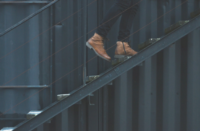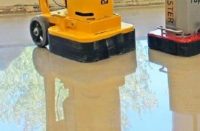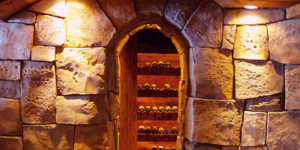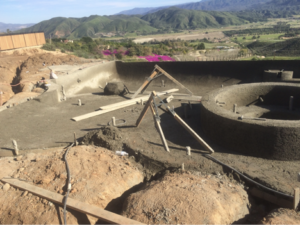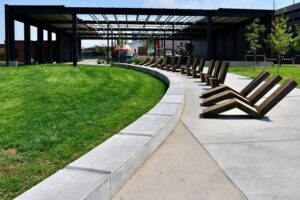
What do you do when your client asks for polished concrete walls? Not many contractors have responded to that request in the affirmative so far, but some are starting to ask, “Why not?”
Gregg Denton, concrete restoration specialist for Jon-Don, suppliers of janitorial and restoration supplies, is one. A reformed “stone snob” he admits that after overcoming his bias he realized that “for every square foot of stone there are a half-million square feet of concrete out there.” The process for polishing stone is the same as polishing concrete, so Denton sees this as a new business opportunity. “It’s not impossible,” he says, “it’s just hard-ass work.”
One reason vertical concrete polishing is hard work, according to Denton, is that it requires all the same steps as a high-quality horizontal job — preparation to get the surface clean, flat and uniform; grinding to remove the cream; honing to a matte finish; and polishing to a reflective surface. “Each diamond’s job is to remove the evidence of the previous one,” Denton explains. “It’s not rocket science, but it is physics. Horizontal polishing is time-consuming, but at least gravity’s your friend. Gravity is anything but your friend on vertical.”
 Nathan Baggett, design and project manager for DreamKrete, Richmond, Va., discovered this when assigned to grind and polish four-foot high walls at the Shops at Willow Lawn outdoor shopping center in Richmond. (See Concrete Decor, July 2012.) He and his colleagues rigged up a cart to bear the weight of a three-headed planetary grinder typically used for countertops. But when they got to the job site they discovered that the ground of the active construction zone was too uneven and cluttered to allow the cart to roll as needed. In the end it took two men using 5-inch hand grinders 18 days, most of the time kneeling, to finish grinding and polishing about 1,800 square feet of vertical concrete. “It was like doing a thousand sit-ups,” Baggett remembers.
Nathan Baggett, design and project manager for DreamKrete, Richmond, Va., discovered this when assigned to grind and polish four-foot high walls at the Shops at Willow Lawn outdoor shopping center in Richmond. (See Concrete Decor, July 2012.) He and his colleagues rigged up a cart to bear the weight of a three-headed planetary grinder typically used for countertops. But when they got to the job site they discovered that the ground of the active construction zone was too uneven and cluttered to allow the cart to roll as needed. In the end it took two men using 5-inch hand grinders 18 days, most of the time kneeling, to finish grinding and polishing about 1,800 square feet of vertical concrete. “It was like doing a thousand sit-ups,” Baggett remembers.
He believes that beginning grinding after the concrete had been in place for only 10 days may have made the earlier stages of the process a little easier than it might have been with fully cured concrete.
Baggett admits that vertical concrete polishing might be a better idea on a smaller scale. He says the cost is between two and three times that of grinding and polishing flatwork, mostly because it is so time-consuming. Referring to a sign he once saw — “Fast food is not good, good food is not fast” — he says, “Good vertical concrete is not fast. It is a costly, slow procedure to have it done to the standards to which we hold ourselves.”
T.B. Penick & Sons, San Diego, sometimes adds small areas of vertical polished concrete to larger jobs. For example, an elevator lobby or the wall behind a reception desk may be polished. “We do accent pieces,” says Victor Klemaske, senior project manager. “It’s fairly expensive because it’s a lot of handwork.” They use the same hand grinders used to finish the edges of horizontal polished concrete. Once again, the challenge is gravity — getting enough pressure on the machine to actually grind and polish. “It’s as much pressure as a man can create just using his arms,” Klemaske explains. If the surface to be polished is higher than about 5 feet, they erect a scaffold so no one will have to use a grinder higher than shoulder height.
 One way Klemaske controls time and cost is to finish the job with wax. “A vertical wall is not a wear surface, so instead of taking it up to a polish with diamonds alone, we add a wax and burnish it like you would a car. This saves cost and provides the shiny surface people are looking for.”
One way Klemaske controls time and cost is to finish the job with wax. “A vertical wall is not a wear surface, so instead of taking it up to a polish with diamonds alone, we add a wax and burnish it like you would a car. This saves cost and provides the shiny surface people are looking for.”
The vertical polished concrete exterior of the expansion to the Saint Louis Art Museum, opened in June, is the opposite of an accent piece. Matt Pfund, vice president for St. Louis-based Tarlton Corp., called the concrete walls “the most unique use of tilt-up I’ve ever seen.” Pfund served as project director on the Tarlton/Pepper/KAI joint venture general contracting team for construction of the new East Building.
Ordinarily a tilt-up panel is poured onto a smooth form so the bottom of the slab is a finished surface. In this case, the top of the slab was ground and polished. In addition, the architect wanted no seams at the corners, so some panels had to be poured with the concrete turning 90 degrees and continuing on for 4 feet.
In all there were 23 panels, each about 23 feet tall and ranging from 15 to 30 feet wide. Contractor Fenix Construction, St. Louis, poured the concrete for each panel on a raised horizontal casting bed so it could be screeded and floated without anyone standing on it and disturbing the aggregate. To make a panel with a corner, the casting bed was erected 4 feet above the ground with an adjacent scaffold built turning down 4 feet. The large part of the panel was poured horizontally and the shorter return section was poured vertically at the same time.
“This job required really crisp edges so we poured big and then saw-cut down to size. This gave us a straighter edge than we would get from forms,” explained Jason Sternau, who oversaw the pour for Tarlton and is now employed by Fenix.
The large horizontal panels were ground and polished with traditional equipment and the return sections were ground and polished with hand grinders. Fenix removed 1/2 to 3/8 inch of concrete for maximum exposure of the large, colorful aggregate. The completed panels were 7 inches thick.

Because of their mass and weight — as much as 80,000 pounds each — the panels were poured as close as possible to the installation site. A 750-ton crane was used to lift them into place, using specialized lifter inserts on the face of the panels. The panels are bolted to a steel frame so they have the appearance of floating. Once the panels were set, the lifter inserts were patched and polished to blend in with the rest of the panel.
Most vertical polishing projects are much smaller — accent pieces, stair risers, low walls — and the contractors who do them use hand grinders they already have. Mark Listermann, sales and product manager for Boride Engineered Abrasives, believes his company’s Easy Edge diamond tool can make the process a little easier. By eliminating metal-bond cup wheels, the tool delivers a consistent scratch pattern that is easily polished by the next step, according to the manufacturer. The Easy Edge’s light weight is an added advantage.
So, will vertical polished concrete catch on? “Vertical polishing is a very time-consuming process if you want an extraordinary outcome,” warns Gregg Denton.
He fears that vertical polishing could repeat the history of concrete countertops. After the counters debuted in high-end commercial and residential installations, other clients asked for them, too, but at lower prices. “You can only go so far before you start cutting out steps to save time and then the quality begins to decline.”
Whether vertical polishing overcomes the laws of gravity and the limits of technology to become a widespread practice remains to be seen, but as the St. Louis Art Museum and other dramatic installations show, the technique has a place in the world of decorative concrete.
